HOW TO CHOOSE ARTIFICIAL TURF INFILL
Turf Infill is available in a wide variety of options including rubber, Zeofill, sand, Durafill, Envirofill, and a few others we will get to shortly. Many times your local pro installer will not even know the options available nor the differences between them.
My wife and I had this experience recently when a rubber infill was used for our turf because it was what the installer always used. We quickly found out how hot rubber infill could get in direct sunlight, which gave me the idea to research this topic thoroughly.
In this guide, I will attempt to answer all of the most frequently asked questions about artificial grass infill to help make you an expert too including what infill options are available, what artificial grass infill is best for pets, how to choose the coolest infill, and a whole lot more.
My wife and I had this experience recently when a rubber infill was used for our turf because it was what the installer always used. We quickly found out how hot rubber infill could get in direct sunlight, which gave me the idea to research this topic thoroughly.
In this guide, I will attempt to answer all of the most frequently asked questions about artificial grass infill to help make you an expert too including what infill options are available, what artificial grass infill is best for pets, how to choose the coolest infill, and a whole lot more.
Why is Infill Needed for Turf?
Infill is used in artificial turf primarily to help keep the blades standing straight up to look as natural as possible. Without infill, over time your turf will lay down and look matted. Here is an example.
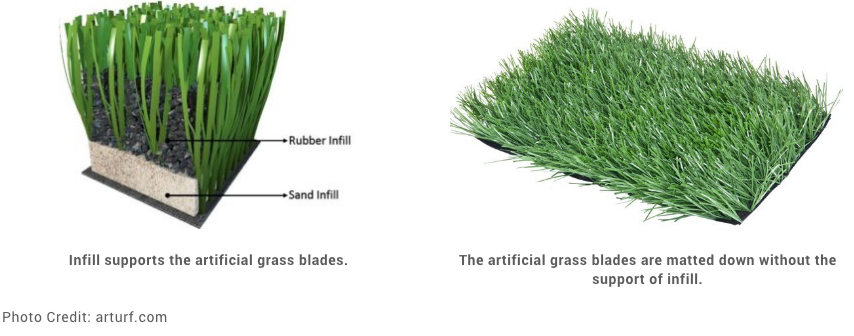
Infill is also used in artificial grass because it acts as a weight to make sure your turf doesn’t get moved around on windy days. Additionally, it helps to protect the lower layer of your turf where the blades connect to the backing sheet. Without it, your grass blades could get damaged over time and fall out. In athletic fields, rubber is the best infill to use to add some extra shock absorption for tackles or falls.
What Types of Turf Infill Options are Available?
The three main types of infill are rubber, sand, and zeolites. Each type has various options/brands available. The most popular choices are the following:
| Rubber | Sands | Zeolites |
|---|---|---|
|
Crumb Rubber
|
Silica Sand
|
Zeofill
|
|
EPDM Rubber
|
Durafill
|
Zeolites Max
|
|
|
Envirofill
|
|
|
|
Hydrochill
|
|
|
|
Putting Green Infill
|
|
Rubber Infill
Rubber is the most common infill used. This infill is available in two types, black crumb rubber which is made from recycled tires, and EPDM virgin rubber which is more expensive but also has less potential contaminants than recycled rubber.Sand Infill
Sands are available in many different varieties. Silica sand tends to be the least expensive turf infill overall but can feel “sharp” or “rough” since it can have micro-sized jagged edges. Beyond that, we offer a variety of more advanced man-made sands that have rounded edges. Others include additives to help them be more microbial resistant or cooler under the sun.Zeolite Infill
Zeolites are natural porous substances that are formed when volcanic rocks and ash react with groundwater. They tend to have a large amount of naturally occurring positive ions in them which makes them great for neutralizing pet odors. It’s one of the most popular infills to use in pet turf but are rarely used as a primary infill.What are the Pros and Cons of Each Type?
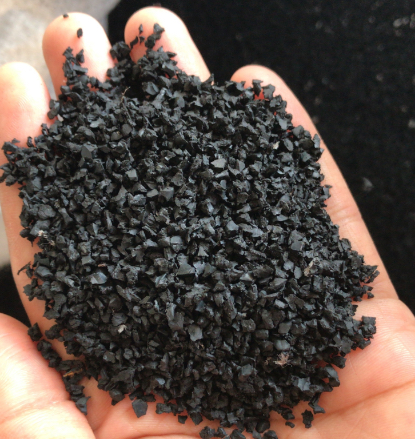
Crumb Rubber
Pros:Crumb rubber infill is the most popular turf infill used and is made from recycled tires. It is inexpensive and will last for years with little to no maintenance required. It is often referred to as SBR Rubber (styrene-butadiene rubber) and is black in color. Since it is recycled, it helps to keep tires out of landfills. It is also generally accepted as one of the best infills for athletic fields since it has good shock absorption qualities.
Cons:
Since this product is made from recycled tires, it tends to be the infill option most often associated with potential health concerns. There hasn’t been a lot of definitive tests one way or the other but there are studies ongoing and Shaw has released their own statement on the topic. Crumb rubber also tends to be the hottest infill in direct sunlight.
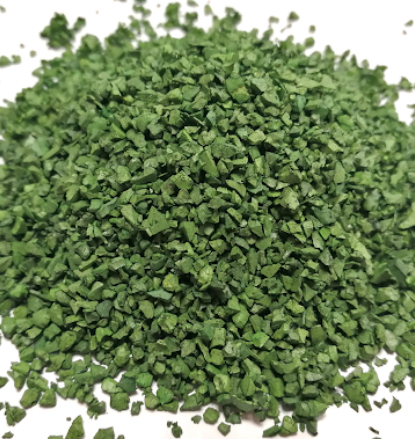
EPDM Rubber
Pros:EPDM (Ethylene Propylene Diene Monomer) rubber is a man-made rubber that can be made in any color and is generally thought to be safer than crumb rubber. It is also very durable, low maintenance and great for use in artificial turf for athletic fields, to help absorb shock.
Cons:
EPDM rubber infill tends to cost more than crumb rubber as it is not recycled. It may also still have some long term health concerns, although once again, studies haven’t definitively stated this yet. EPDM infill can also get quite hot on a sunny summer day.

Silica Sand
Pros:This is the second most widely used infill as sand is the least expensive, widely available, and generally considered very safe to use. Sand does tend to be slightly cooler in direct sunlight than rubber and does a fairly decent job eliminating some odors naturally.
Cons:
Raw silica sand tends to have microscopic jagged edges. This is usually fine if the area is lightly used. However if the turf will see a lot of foot traffic, this could cause the sand to wear down the artificial grass blades over time. Sand infill can also be more abrasive if people were to fall and slide on the turf. To address these challenges, we only sell silica sand with rounded edges, which decreases the abrasiveness. Silica sand also does not have much cushioning to help absorb falls or tackles which is why it is almost never used in athletic fields. Additionally, silica sand can soak up moisture, like pet urine, which then leads to bacteria growth and unpleasant smells.
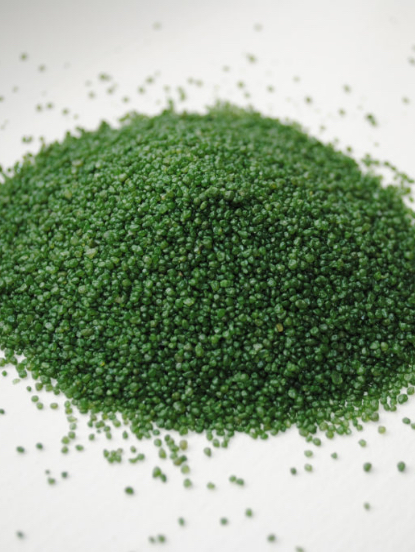
Durafill / EnviroFill
Pros:First let me start by saying that Durafill and EnviroFill are the same thing. Over the years many manufacturers or turf brands have created their own brand names like wonderfill for the same product. Durafill a.k.a. Envirofill is essentially a manufactured sand that has less sharp edges than regular sand. This makes it safer for kids to play on versus regular silica sand. It also tends to have slightly more shock absorption qualities than silica sand.
Durafill is also an excellent high traffic area turf infill since the “rounder” edges of the product are easier on the artificial grass blades over time. It also has built-in Microban technology that claims to help prevent microbes such as odor-causing bacteria resulting from pet urine. This infill also tends to be cooler than rubber on hot sunny days and is generally thought to be safe and free of any toxins.
Cons:
Durafill sand is still very similar to silica sand in that it does not have a lot of cushioning properties and is still more abrasive against skin than a rubber infill. If you are planning on using your area for soccer or other athletic events, it is probably best to stick with a rubber infill.
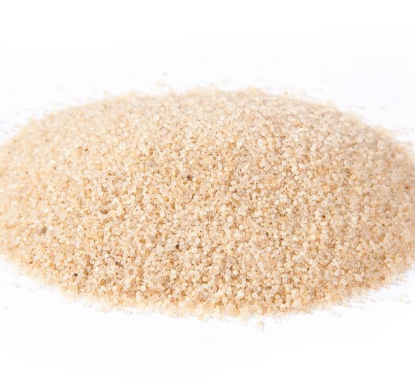
Hydrochill
Pros:Hydrochill (a.k.a. Chill fill) is the coolest infill available hands down. It is made of sand that’s covered with a proprietary coating from the manufacturer. With the help of evaporative cooling (think spraying the turf off quickly with a hose or sprinkler), this coating slows heat absorption in direct sunlight and sheds heat at a better rate than any other infill.
Cons:
Hydrochill is a sand so it will have similar downsides as that of other sands. It won’t absorb shock very well, and it will be slightly more abrasive if one were to slide on it like in soccer.

Putting Green Infill
Pros:Putting green infill tends to be a finer mesh version of Durafill. Think of it as a very fine sand to help ensure putts roll smoothly, because it’s small enough to fit into all the small crevices of putting green turf. The more infill you use, the better the stimp reading, so the ball will roll better and faster. Some versions of this also contain a blend of green and black Durafill to ensure a deep dark green color, compared to the lighter, more noticeable color of silica sand infill Putting green infill or similar fine mesh infills are the best option for lower pile height artificial turfs.
Cons:
If you are installing a putting green, there really are none. This is the best infill option for the job.
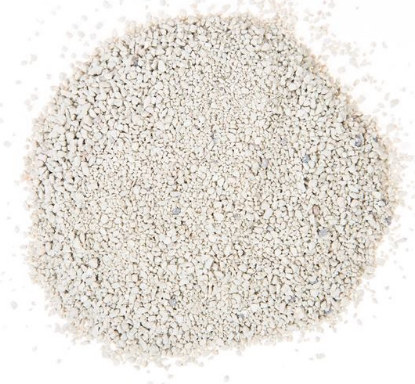
ZeoFill / Zeolite Max
Pros:Zeolite infill (a.k.a. Zeofill or Zeolite Max) is a naturally occurring substance this is generally considered the best infill to use to help eliminate pet waste smells. Zeolite is also very porous which helps to keep your turf cooler in direct sunlight compared to most rubber or sand infill options.
Cons:
Zeolite can be too lightweight for use as a primary infill. Generally, it is best to use a heavier infill, such as one of the sand or rubber infills, as your base infill and to then add a secondary infill layer of Zeolite as your top layer.
What is the Best Artificial Grass Infill for Pets?

If you live in an area that gets a lot of sun, you will find out pretty quickly that artificial turf will get hotter in direct sunlight than natural grass. In fact, depending on the type of infill you choose, it can get so hot that your pets may not even want to go on it. This is especially a problem in southern states like Arizona where I live. To learn more about which turf infill options stay coolest, click here.
The other issue you have to deal with as a pet owner is your pet(s) going to the bathroom on your turf. Some infills do a better job draining and eliminating the smells of urine more than others. In general, the best infill options for pet turf infills are Zeolites and Durafills. Zeolite is an organic infill made from volcanic ash that naturally has a lot of positive ions, which helps to neutralize the smells of pet waste. Durafill has an antimicrobial coating called Microban.
If you live in a very sunny climate, the third-best option to consider for pets is probably Hydrochill, as it drains well and is the coolest option. The last option we would recommend is silica sand. You can also use any combination of Durafill, Zeolite, silica sand, or Hydrochill to get the benefits of each. We don’t normally recommend pure rubber infill for use with pets as it can get uncomfortably hot on their paws in the summer.
The other issue you have to deal with as a pet owner is your pet(s) going to the bathroom on your turf. Some infills do a better job draining and eliminating the smells of urine more than others. In general, the best infill options for pet turf infills are Zeolites and Durafills. Zeolite is an organic infill made from volcanic ash that naturally has a lot of positive ions, which helps to neutralize the smells of pet waste. Durafill has an antimicrobial coating called Microban.
If you live in a very sunny climate, the third-best option to consider for pets is probably Hydrochill, as it drains well and is the coolest option. The last option we would recommend is silica sand. You can also use any combination of Durafill, Zeolite, silica sand, or Hydrochill to get the benefits of each. We don’t normally recommend pure rubber infill for use with pets as it can get uncomfortably hot on their paws in the summer.
Which Turf Infill Stays the Coolest?

Turf can and will get hotter in direct sunlight than natural grass. There is no way around this. For example, here in AZ last year on a sunny 114℉ day, I went to a friend’s house who had both natural grass and turf in his yard. I checked the surface temperatures of both using an infrared thermometer. The natural grass was reading 95℉ while the turf with a rubber infill was reading 130℉.
I didn’t notice it much at the time since I was wearing shoes, however later when we were walking around barefoot, it was quite noticeable. In fact, Penn State even has a study on this using black crumb rubber and was able to get a 50℉ difference between natural grass and artificial turf.
So what are you to do if you want the zero maintenance and always perfectly manicured lawn look of artificial turf, but you also want it to be cool for your family and pets to walk on? Lucky for you, we have done the research on what infills keep your lawn the coolest and by how much. We put a video together to show how we did it.
I didn’t notice it much at the time since I was wearing shoes, however later when we were walking around barefoot, it was quite noticeable. In fact, Penn State even has a study on this using black crumb rubber and was able to get a 50℉ difference between natural grass and artificial turf.
So what are you to do if you want the zero maintenance and always perfectly manicured lawn look of artificial turf, but you also want it to be cool for your family and pets to walk on? Lucky for you, we have done the research on what infills keep your lawn the coolest and by how much. We put a video together to show how we did it.
And here are those final results:
| Infill | Post-Sun Temperature | Post Water Evaporative Cooling |
|---|---|---|
|
Control (Turf with No Infill)
|
159.4℉
|
136.5℉
|
|
Black Crumb Rubber
|
161.7℉
|
142.9℉
|
|
Silica Sand
|
155.4℉
|
126.7℉
|
|
Durafill
|
153.3℉
|
129.4℉
|
|
Zeolite Max
|
150.8℉
|
124.7℉
|
|
Hydrochill
|
145.1℉
|
114.0℉
|
How Much Do Different Artificial Grass Infills Cost?

Artificial turf infills can cost anywhere from 35-90 cents per square foot depending on the type of infill you use. Here is a general breakdown to show how we currently have them priced as of 2/25/20:
| Infill | Cost Per Square Foot |
|---|---|
|
Black Crumb Rubber
|
$0.83
|
|
Silica Sand
|
$0.35
|
|
Durafill
|
$0.83
|
|
Zeolite Max
|
$0.83
|
|
Hydrochill
|
$0.83
|
|
Putting Green Infill
|
$0.89
|
These prices are for 50 lb bags added to turf at the rate of 1.5 lbs per square foot, so if you have a larger job where you plan on doing an entire yard or field, bulk purchases can be made that will bring the price down further. Please feel free to contact our sales team if you would like to inquire about bulk infill purchases at (866) 416-6388.
How Much Infill Do You Need?
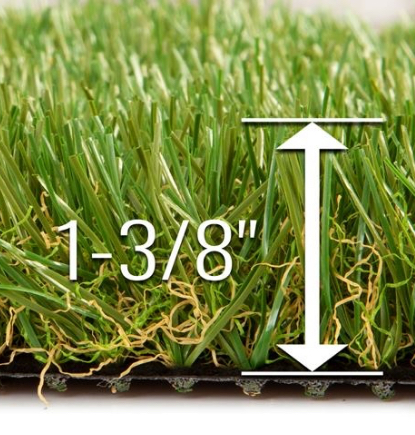
In general, most landscape, pet, or athletic turf installations require about 1.5-4.0 lbs of infill per square foot of turf. This is usually enough to act as a good amount of weight to ballast the turf down and to keep the artificial grass blades standing straight up. However, you may need slightly more or less infill depending on the pile height of the turf you select.
Pile height is, in essence, the length of the artificial blades of grass. The taller the pile height, the more infill you will need. As an example, USGreenTech provides a resource to show how much Durafill you would need per sqft depending on the pile height.
Pro tip: If you have pets who may occasionally poop on the turf, lean towards a lower pile height. This will allow the droppings to stay on top of the blades rather than get embedded deeper into the blades. If you do not have pets and want a lush feeling grass underfoot, lean towards a higher pile height turf.
Pile height is, in essence, the length of the artificial blades of grass. The taller the pile height, the more infill you will need. As an example, USGreenTech provides a resource to show how much Durafill you would need per sqft depending on the pile height.
Pro tip: If you have pets who may occasionally poop on the turf, lean towards a lower pile height. This will allow the droppings to stay on top of the blades rather than get embedded deeper into the blades. If you do not have pets and want a lush feeling grass underfoot, lean towards a higher pile height turf.
How Do You Install Turf Infill?

The easiest way to install infill is to use a landscape spreader to evenly distribute the infill over the entire artificial grass surface. You will then want to use a power broom and go against the grain of the lawn to make sure the bristles end up in the upright position.
If you notice some low areas or areas that are still matted down, you can add more infill and brush the synthetic turf further. For more information, there are plenty of great install videos readily available online here.
If you notice some low areas or areas that are still matted down, you can add more infill and brush the synthetic turf further. For more information, there are plenty of great install videos readily available online here.
Can You Mix Infills and Should You?
The simple answer is yes, you can mix infills, and oftentimes we recommend it. For the easiest and quickest installation, you may want to choose one standard infill by itself. However, if you want to meet multiple needs, mixing infills is often the best option.
For example, say you want some turf that can be used for kids soccer but also doesn’t get too hot in the summer. Some of our customers have had success with using rubber as the base infill and putting a thin layer of Hydrochill or Zeolite on top. Or say you want a beautiful pet turf that is inexpensive and cool to the touch. Some customers have used silica sand as their base layer with a thin layer of Zeolite on top.
For example, say you want some turf that can be used for kids soccer but also doesn’t get too hot in the summer. Some of our customers have had success with using rubber as the base infill and putting a thin layer of Hydrochill or Zeolite on top. Or say you want a beautiful pet turf that is inexpensive and cool to the touch. Some customers have used silica sand as their base layer with a thin layer of Zeolite on top.
Turf Infill Takeaways

Choosing the best turf infill for you can seem intimidating at first given the lack of quality information available online. In general, these are the basic tips:
- Silica sand is the cheapest
- Rubber is the best option for athletic fields
- Zeolites are the best for neutralizing pet smells
- Durafill is perhaps the best all-around do it all option
- Hydrochill is by far the coolest
- For lower pile height turfs like putting greens, get a finer mesh sized infill like a dedicated putting green turf


